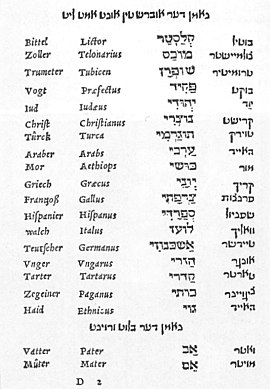Jewish languages

Jewish languages are the various languages and dialects that developed in Jewish communities around the world.
History
[change | change source]Although Hebrew was the daily speech of the Jewish people for centuries, by the 5th century, the closely related Aramaic joined Hebrew as the spoken language in Judea[1] where the ancient Jews, "Judeans", where the word "Jew" comes from, lived. By the 3rd century Jews of the diaspora (Jewish people outside of their country) were speaking Greek, and soon afterwards Hebrew was no longer used as a first language - for over sixteen centuries being used almost only as a liturgical language (for prayer)[2] until revived as a spoken language by Eliezer Ben-Yehuda in the Palestine of the late 1880s and eventually becoming the official language of the state of Israel.[3]
Development
[change | change source]For centuries Jews worldwide spoke the local or dominant languages of the regions they migrated to, often developing distinctive dialectal forms or branching off as independent languages.
The usual way these languages developed was through the addition of Hebrew words, phrases, and sometimes grammar used to express uniquely Jewish concepts and concerns. Often they were written in Hebrew letters, including the block letters used in Hebrew today and Rashi script. Due to the isolated nature of many Jewish communities, many Jewish languages retained archaic (old) vocabulary and linguistic structures of the language from which they descended long after they had been lost or changed in later forms of the parent language.[4]
Widely spoken
[change | change source]Among the most widely spoken Jewish languages to develop in the diaspora are Yiddish, Ladino, and the Judæo-Arabic group of languages. Yiddish is the Judeo-German language developed by Ashkenazi Jews who migrated to Central Europe, and Ladino, also called Judezmo and Muestra Spanyol (our Spanish), is the Judeo-Spanish language developed by Sephardic Jews who lived in the Iberian peninsula.
Many ancient and distinct Jewish languages, including Gruzinic (Jewish Georgian), Judeo-Arabic, Judeo-Berber, Krymchak (Jewish Uzbek) and Judeo-Malayalam (a kind of Indian language) have largely fallen out of use due the impact of the Holocaust on European Jewry, the Jewish exodus from Arab lands, the assimilation policies of Israel in its early days and other factors.
Yiddish was the language spoken by the largest number of Jews in the 1850s, but today the three most commonly spoken languages among Jews are English, modern Hebrew, and Russian—in that order.[5] Some people think that since Jews who use English and Russian have a lot of Jewish things to say and ways to say them, one day there might be a Judeo-English and maybe Judeo-Russian language.
References
[change | change source]- ↑ Grintz, Jehoshua M. "Hebrew as the Spoken and Written Language in the Last Days of the Second Temple." Journal of Biblical Literature. March, 1960.
- ↑ Parfitt, T. V. "The Use of Hebrew in Palestine 1800–1822." Journal of Semitic Studies , 1972.
- ↑ Zuckermann, Ghil'ad (2003). Language Contact and Lexical Enrichment in Israeli Hebrew. Palgrave Macmillan. (ISBN 9781403917232 / ISBN 9781403938695)
- ↑ Zuckermann, Ghil'ad (2014). Jewish Language Contact (International Journal of the Sociology of Language 226)
- ↑ "Jewish Languages". Beth Hatefutsoth, The Nahum Goldmann Museum of the Jewish Diaspora. Archived from the original on 2009-03-26. Retrieved 2008-07-03.
